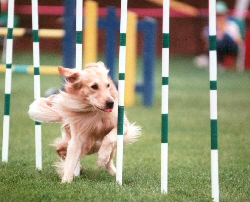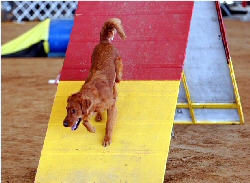How to train your dog to work
away from you
 Jane
Simmons-Moake says that one of the most common questions people ask her at seminars and at
agility trials is 'How do you teach your dog to work at a distance?' Someone actually
asked her this while she was the queue to enter the ring with only two dogs ahead of her. To
which the handler ahead of her chimed in with a perfect five-word answer, saying 'Buy Jane's
books and DVDs!' It is a complex question that cannot be explained in five words and deserves a
thorough and thoughtful answer which Jane attempts to provide in this article. Jane
Simmons-Moake says that one of the most common questions people ask her at seminars and at
agility trials is 'How do you teach your dog to work at a distance?' Someone actually
asked her this while she was the queue to enter the ring with only two dogs ahead of her. To
which the handler ahead of her chimed in with a perfect five-word answer, saying 'Buy Jane's
books and DVDs!' It is a complex question that cannot be explained in five words and deserves a
thorough and thoughtful answer which Jane attempts to provide in this article.
Many people begin their agility
training by running closely alongside their dog. This can be a successful strategy at the
beginner levels of competition especially for those with slower or moderately paced dogs
competing on simple courses. Eventually, as your dog moves up to higher levels of competition,
this strategy no longer works for every situation. It soon becomes clear that the ability to
handle at a distance when needed would be an asset - or even a necessity - to achieving your
agility goals. Distance handling is now essential for excelling on Agility, Jumping and Games
courses. Distance skills allow you to smoothly handle courses with handler restrictions. They
also enable your dog to perform courses at his fastest possible speed, rather than be limited
by yours.
 Retrain
to gain Retrain
to gain
People who have been running closely alongside their dogs for a long period of time often
have a hard time making the transition to being able to handle at a distance. Old habits are
hard to break - even more so for the dog than the handler. Some handlers become so frustrated
when teaching their dogs to work at a distance that they feel like their dog is attached to
their leg with Velcro. You have probably been rewarding your dog for staying close to you and
not running ahead. He thinks this is the behaviour you are looking for. To accomplish your goal
of being able to handle at a distance whenever needed or desired, you will need to adjust the
'rules' by which you and your dog perform Agility, as well as your reward system.
To achieve your goal of working at a
distance, you will need to back up in your training and undertake some gradual, systematic
retraining. You will need to train your dog to perform each of the obstacles at a distance with
speed and accuracy. Then, you will need to train a set of consistent body cues that will
communicate as well at a distance as they do when you are close to your dog. If you merely
change the rules without sufficient, patient retraining, your dog won't know how to succeed.
Expecting results without this proper foundation work can damage your dog's happy attitude and
his trust in you as a team leader.
Begin your retraining program by
calling your dog to you over/through each of the individual obstacles at a variety of angles
and distances. Moving toward you, your dog will be motivated to move at his fastest speed. At
the same time, he will gain skill and confidence at working independently from you. Then,
progress to sending your dog away from you to each of the obstacles. Begin with short distances
(4 – 5 feet) and gradually work up to longer distances (20 - 30 feet or more.)
With all of your calling and sending to
individual obstacles, insist on speed and precision regardless of your distance from the
obstacle. Make it easy for the dog to approach the contact obstacles squarely and to touch the
contact zones by using aids such as wire guides, hoops, or targets.
 With
weave poles, it's a good idea to examine your dog's weaving performance before asking him to
weave at a distance. Does your dog rely on your hand or body, or look up at you for direction
through each pole? If so, you have either intentionally or inadvertently made yourself an
integral part of the weaving process. Once you try to move away from the poles, your dog will
not know how to perform them. If this sounds like your situation, you will need to retrain the
weave poles before being able to handle them at a distance. With
weave poles, it's a good idea to examine your dog's weaving performance before asking him to
weave at a distance. Does your dog rely on your hand or body, or look up at you for direction
through each pole? If so, you have either intentionally or inadvertently made yourself an
integral part of the weaving process. Once you try to move away from the poles, your dog will
not know how to perform them. If this sounds like your situation, you will need to retrain the
weave poles before being able to handle them at a distance.
Once you can call and send to each of
the obstacles individually, you are ready to start handling at a distance on a sequence of
obstacles. Start with short sequences that require no side-switches. Pattern your dog by
performing the sequence at a comfortably close distance. Then, repeat it, progressively gaining
more and more lateral distance from the obstacles.
To develop linear distance skills
(sending your dog ahead over several obstacles) start with short, straight-line sequences,
using a toy or target at the end of the sequence. Increase your distance by adding obstacles to
the start of the sequence, leaving the end of the sequence and target in the same position
throughout the progression. Be careful not to accept refusals at any stage of your training. At
the same time, make sure you are doing your part by giving your commands on time and are giving
unambiguous body cues.
 Persevere Persevere
Don't be discouraged if your dog does not catch on immediately to your new agenda. Some
dogs, especially ones with a good deal of drive or independence, may be immediately grateful
for the opportunity to work at a distance -to open up at their own top speed. Others who are
less adventurous may need more time to discover the fun in working together, yet separately,
from their handlers.
When training something new, you will
often take two steps forward -then one step back. What may very well happen after you have
trained your dog to soar at a distance is that he may start taking a few extra obstacles on his
own for a while. This is to be expected. You've taught him to enjoy looking confidently for the
line of obstacles ahead. You will now need to work on being able to reel him in or change his
direction at will. To accomplish this, use lots of variations on a theme. Pattern a sequence
then inject unexpected changes in direction and call-offs followed by extra-special rewards.
Eventually, set up sequences in which you alternate between sending your dog to work at a
distance and bringing him back to you to work under tighter control.
If I've made developing distance skills
sound like a lot of work, it can be - especially, if you have spent a long time doing agility
with your dog glued to your side. Is all the work worth it? Absolutely! If you have never
worked with your dog at a distance, you have not yet discovered the joy of traversing an
agility course independently, yet together.
As a result of your training your dog
will be able to move through the course at his highest potential speed, unencumbered by any
risky attempts to race him to an obstacle and cut him off for a turn. Your dog's jumping and
movements will be smooth, natural, and a joy to behold. Most of all, you will have a powerful
new tool in your arsenal to call upon whenever distance handling would be to your advantage.
If you want to learn
more about handling your dog at a distance, you can buy Jane's book Unleashing the Velcro Dog,
available from Agility
Warehouse.
Review
 About
the author... About
the author...
Jane Simmons-Moake is one of the world's foremost agility trainers. A top-winning
competitor, veteran judge, and award-winning author of five books and three DVDs, Jane has also
competed internationally as a member of the 1996 and 1997 AKC U.S. World Championship Agility
Teams, and was the 20th National Champion at the 2006 AKC Agility Invitational.
Jane was one of the earliest pioneers
in US agility, having entered the sport in 1986. She has given over a hundred seminars
throughout the US as well as Europe, Japan, South America, Canada and Mexico.
You can see Jane put her winning
methods to use in competition by visiting
www.youtube.com/janesm11 .
|